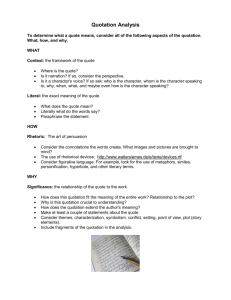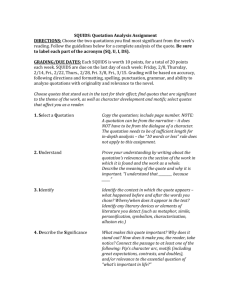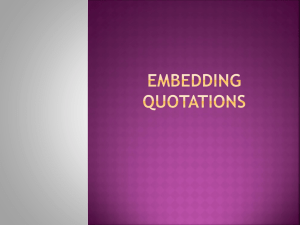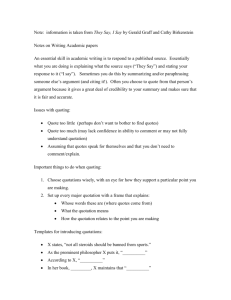Introducing and Explaining Source Material
advertisement
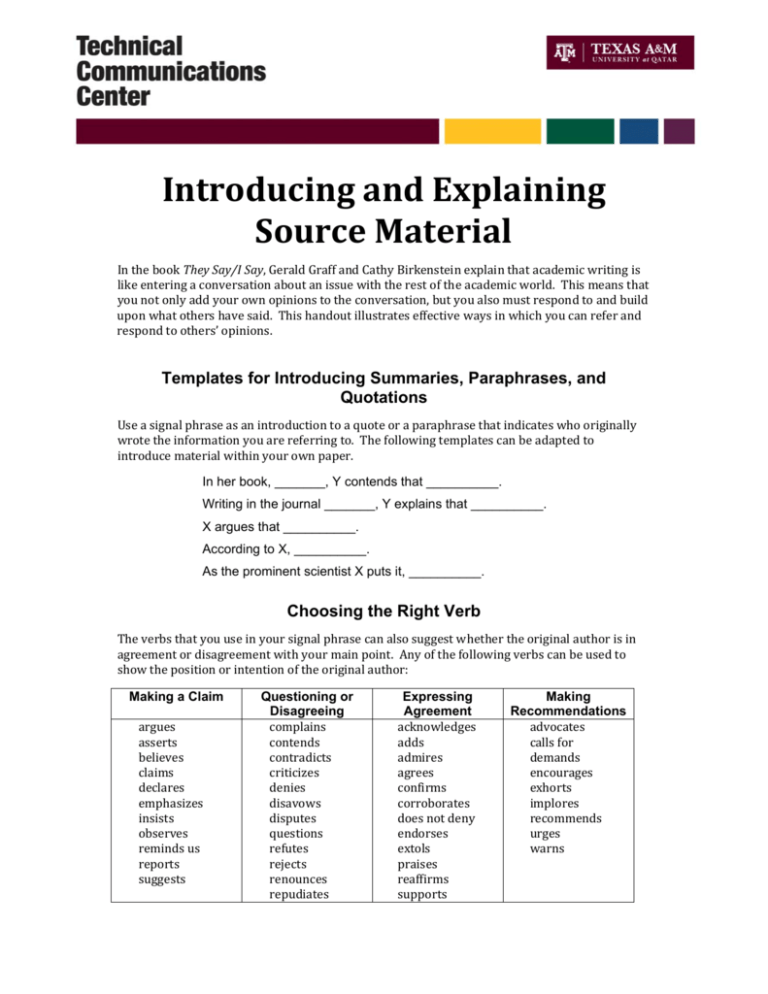
Introducing and Explaining Source Material In the book They Say/I Say, Gerald Graff and Cathy Birkenstein explain that academic writing is like entering a conversation about an issue with the rest of the academic world. This means that you not only add your own opinions to the conversation, but you also must respond to and build upon what others have said. This handout illustrates effective ways in which you can refer and respond to others’ opinions. Templates for Introducing Summaries, Paraphrases, and Quotations Use a signal phrase as an introduction to a quote or a paraphrase that indicates who originally wrote the information you are referring to. The following templates can be adapted to introduce material within your own paper. In her book, _______, Y contends that __________. Writing in the journal _______, Y explains that __________. X argues that __________. According to X, __________. As the prominent scientist X puts it, __________. Choosing the Right Verb The verbs that you use in your signal phrase can also suggest whether the original author is in agreement or disagreement with your main point. Any of the following verbs can be used to show the position or intention of the original author: Making a Claim argues asserts believes claims declares emphasizes insists observes reminds us reports suggests Questioning or Disagreeing complains contends contradicts criticizes denies disavows disputes questions refutes rejects renounces repudiates Expressing Agreement acknowledges adds admires agrees confirms corroborates does not deny endorses extols praises reaffirms supports Making Recommendations advocates calls for demands encourages exhorts implores recommends urges warns Explaining Quotations With quotes especially, it is important to not only introduce the quotation, but also to explain it afterwards with some follow‐up statement that tells what you interpret the quote to mean and how the quote relates to the larger point you are trying to make—in other words, “frame” the quotation. Consider the following example of a quote that is not properly framed: The author .. Amato reports, “Near the middle of the 19th century, only about 5% of first marriages ended in divorce. In contrast, demographers estimate that about half introduces the quote, but does not give an indication of how it supports her thesis. of first marriages initiated in recent years will be voluntarily dissolved.” Another point that Amato makes is that ... The above example shows a “dumped quote,” meaning the quote was just dumped into the paper without any explanation. There is no statement to help us interpret the quotation or relate the quotation to the author’s thesis. In the example below, however, the author’s statement after the quotation highlights the main point that he wants his readers to understand from the quotation: th Amato reports, “Near the middle of the 19 century, only about 5% of first The author marriages ended in divorce. In contrast, demographers estimate that about half interprets the of first marriages initiated in recent years will be voluntarily dissolved.” This quote. means that in two generations, the rate of divorce has increased from one marriage in twenty to ten marriages in twenty. This is incredible growth. Looking The author at these statistics, it is clear to see that with such a change in the basic structure comments on the quote, tying of the family, there will surely be some implications on society. it to her thesis. Another point that Amato makes is that... Templates for Explaining Quotations The following templates model ways that you can begin an explanatory statement after a quotation: Basically, X is saying that __________. In other words, X believes that __________. In making this comment, X argues that __________. X is insisting that __________. X’s point is that __________. The essence of X’s argument is that __________. Adapted from They Say/I Say: The Moves that Matter in Academic Writing, by Gerald Graff and Cathy Birkenstein Technical Communications Center • Texas A&M University at Qatar Access all of our handouts online at www.qatar.tamu.edu/tcc/
